Sequential Game Model for Urban Emergency Human–Machine Collaborative Decision-Making
Abstract
1. Introduction
- (1)
- Are there cooperative decision-making motives for humans and machines in urban emergency management?
- (2)
- Under what conditions are cooperative human–machine decisions triggered?
- (3)
- How does human–machine collaborative decision-making affect the total science and technology inputs and total benefits of urban emergency management?
2. Methodology
2.1. Basic Description of the Model
2.2. Model Solution
2.2.1. Stage 3: Single Decision-Making
2.2.2. Stage 2: Assisted Decision-Making
2.2.3. Stage 1: Human–Machine Collaborative Decision-Making
| Algorithm 1: Human–machine collaborative decision-making algorithm |
 |
3. Results
3.1. Establishment of Human–Machine Collaborative Decision-Making
3.2. Impact of Cooperative Human–Machine Decision-Making on the Level of S&T
3.3. Impact of Cooperative Human–Machine Decision-Making on
3.4. Discussion of the Difference in Between Humans and Machine
4. Conclusions
Author Contributions
Funding
Data Availability Statement
Acknowledgments
Conflicts of Interest
Nomenclature
| Parameters | equilibrium benefits of assisted decision-making of | ||
| decision sets of participants | the additional benefit of assisted decision-making of | ||
| decision space | the total benefit of urban emergency management of assisted decision-making of | ||
| initial marginal decision cost | the equilibrium level of S&T inputs of cooperative decision-making of | ||
| S&T inputs | equilibrium decision quantity of cooperative decision-making of | ||
| the costs of the other aspects of the governance process | equilibrium benefits of cooperative decision-making of | ||
| the spillover coefficient | the additional benefit of cooperative decision-making of | ||
| the S&T input coefficient | the total benefit of urban emergency management of cooperative decision-making of | ||
| decision benefits of | differential of profitability between independent and cooperative decision-making of | ||
| the relative efficiency | |||
| independent governance | Acronyms | ||
| cooperative governance | science & technology | ||
| the equilibrium decision quantity of | |||
| decision benefit of assisted decision-making of | |||
| the equilibrium level of S&T inputs of assisted decision-making of | |||
| equilibrium decision quantity of assisted decision-making of |
Appendix A
References
- Liu, W.P.; Su, Y.G.; Wu, W.Q.; Xin, C. Man-machine collaboration method for cataract capsulorhexis using virtual fixture. Future Gener. Comput. Syst.-Int. J. Escience 2019, 98, 522–529. [Google Scholar] [CrossRef]
- Jussupow, E.; Spohrer, K.; Heinzl, A.; Gawlitza, J. Augmenting medical diagnosis decisions? An investigation into physicians’ decision-making process with artificial intelligence. Inf. Syst. Res. 2021, 32, 713–735. [Google Scholar] [CrossRef]
- Mishra, R.; Singh, R.K.; Daim, T.U.; Wamba, S.F. Integrated usage of artificial intelligence, blockchain and the internet of things in logistics for decarbonization through paradox lens. Transp. Res. Part E-Logist. Transp. Rev. 2024, 189, 103684. [Google Scholar]
- Peternel, L.; Tsagarakis, N.; Ajoudani, A. A human-robot co-manipulation approach based on human sensorimotor information. IEEE Trans. Neural Syst. Rehabil. Eng. 2017, 25, 811–822. [Google Scholar] [CrossRef] [PubMed]
- Crandall, J.W.; Oudah, M.; Tennom, I.O.; Abdallah, S.; Bonnefon, J.-F.; Cebrian, M.; Shariff, A.; Goodrich, M.A.; Rahwan, I. Cooperating with machines. Nat. Commun. 2018, 9, 233. [Google Scholar] [CrossRef]
- Dehaene, S.; Lau, H.; Kouider, S. What is consciousness, and could machines have it? Science 2017, 358, 486–492. [Google Scholar] [CrossRef]
- Peternel, L.; Tsagarakis, N.; Caldwell, D.; Ajoudani, A. Robot adaptation to human physical fatigue in human-robot cmanipulation. Auton. Robot. 2018, 42, 1011–1021. [Google Scholar] [CrossRef]
- Xiong, W.; Fan, H.; Ma, L.; Wang, C. Challenges of human-machine collaboration in risky decision-machine collaboration in risky decision-making. Front. Eng. Manag. 2022, 9, 89–103. [Google Scholar] [CrossRef]
- Huang, H.; Rau, P.L.P.; Ma, L. Will you listen to a robot? Effects of robot ability, task complexity, and risk on human decision-making. Adv. Robot. 2021, 35, 1156–1166. [Google Scholar] [CrossRef]
- Shirado, H.; Christakis, N.A. Locally noisy autonomous agents improve global human coordination in network experiments. Nature 2017, 545, 370–374. [Google Scholar] [CrossRef] [PubMed]
- Jarrahi, M.H. Artificial intelligence and the future of work: Human-AI symbiosis in organizational decision making. Bus. Horiz. 2018, 61, 577–586. [Google Scholar] [CrossRef]
- Haesevoets, T.; De Cremer, D.; Dierckx, K.; Van Hiel, A. Human-machine collaboration in managerial decision making. Comput. Hum. Behav. 2021, 119, 106730. [Google Scholar] [CrossRef]
- Illankoon, P.; Tretten, P.; Kumar, U. Modelling human cognition of abnormal machine behaviour. Hum.-Intell. Syst. Integr. 2019, 1, 3–26. [Google Scholar] [CrossRef]
- Rahwan, I.; Cebrian, M.; Obradovich, N.; Bongard, J.; Bonnefon, J.-F.; Breazeal, C.; Crandall, J.W.; Christakis, N.A.; Couzin, I.D.; Jackson, M.O.; et al. Machine behaviour. Nature 2019, 568, 477–486. [Google Scholar] [CrossRef] [PubMed]
- Shan, S.N.; Zhang, Z.C.; Ji, W.Y.; Wang, H. Analysis of collaborative urban public crisis governance in complex system: A Multi-agent Stochastic Evolutionary Game Approach. Sustain. Cities Soc. 2023, 91, 104418. [Google Scholar] [CrossRef]
- Cahlíková, J.; Cingl, L.; Levely, I. How stress affects performance and competitiveness across gender. Manag. Sci. 2020, 66, 3295–3310. [Google Scholar] [CrossRef]
- Pan, D.; Zhang, Y.; Li, Z. Predictive capability of cognitive ability and cognitive style for spaceflight emergency operation performance. Int. J. Ind. Ergon. 2016, 54, 48–56. [Google Scholar] [CrossRef]
- Kleinberg, J.; Lakkaraju, H.; Leskovec, J.; Ludwig, J.; Mullainathan, S. Human Decisions and Machine Predictions. Q. J. Econ. 2018, 133, 237–293. [Google Scholar] [CrossRef]
- Alon Barkat, S.; Busuioc, M. Human-AI Interactions in Public Sector Decision Making: “Automation Bias” and Selective Adherence to Algorithmic Advice. J. Public Adm. Res. Theory 2023, 33, 153–169. [Google Scholar] [CrossRef]
- Veale, M.; Brass, I. Administration by Algorithm? Public Management Meets Public Sector Machine Learning. In Algorithmic Regulation; Yeung, K., Lodge, M., Eds.; Oxford Press: Oxford, UK, 2019. [Google Scholar]
- Bullock, J.B. Artificial Intelligence, Discretion, and Bureaucracy. Am. Rev. Public Adm. 2019, 49, 751–761. [Google Scholar] [CrossRef]
- Grimmelikhuijsen, S. Explaining Why the Computer Says No: Algorithmic Transparency Affects the Perceived Trustworthiness of Automated Decision-making. Public Adm. Rev. 2022, 83, 241–262. [Google Scholar] [CrossRef]
- Höchtl, J.; Parycek, P.; Schöllhammer, R. Big Data in the Policy Cycle: Policy Decision Making in the Digital Era. J. Organ. Comput. Electron. Commer. 2016, 26, 147–169. [Google Scholar] [CrossRef]
- Schaefer, K.E.; Chen, J.Y.; Szalma, J.L.; Hancock, P.A. A Meta-analysis of Factors Influencing the Development of Trust in Automation: Implications for Understanding Autonomy in Future Systems. Hum. Factors 2016, 58, 377–400. [Google Scholar] [CrossRef] [PubMed]
- Dietvorst, B.J.; Simmons, J.P.; Massey, C. Algorithm Aversion: People Erroneously Avoid Algorithms after Seeing Them Err. J. Exp. Psychol. Gen. 2015, 144, 114. [Google Scholar] [CrossRef]
- Longoni, C.; Bonezzi, A.; Morewedge, C.K. Resistance to Medical Artificial Intelligence. J. Consum. Res. 2019, 46, 629–650. [Google Scholar] [CrossRef]
- Logg, J.M.; Minson, J.A.; Moore, D.A. Algorithm Appreciation: People Prefer Algorithmic to Human Judgment. Organ. Behav. Hum. Decis. Process. 2019, 151, 90–103. [Google Scholar] [CrossRef]
- Meissner, P.; Keding, C. The Human Factor in AI-based Decision-making. MIT Sloan Manag. Rev. 2021, 63, 1–5. [Google Scholar]
- Taber, C.S.; Lodge, M. Motivated Skepticism in the Evaluation of Political Beliefs. Am. J. Political Sci. 2006, 50, 755–769. [Google Scholar] [CrossRef]
- Höddinghaus, M.; Sondern, D.; Hertel, G. The Automation of Leadership Functions: Would People Trust Decision Algorithms. Comput. Hum. Behav. 2021, 116, 106635. [Google Scholar] [CrossRef]
- Bigman, Y.E.; Gray, K. People are Averse to Machines Making Moral Decisions. Cognition 2018, 181, 21–34. [Google Scholar] [CrossRef]
- Shan, S.-N.; Zhang, Z.-C.; Wang, C.-J.; Han, G.-Q. Diffusion model of multi-agent collaborative behavior in public crisis network based on complex network evolutionary game. RAIRO—Oper. Res. 2024, 58, 2797–2815. [Google Scholar] [CrossRef]
- Green, B.; Chen, Y. Disparate Interactions: An Algorithm-in-the-loop Analysis of Fairness in Risk Assessments. In Proceedings of the Conference on Fairness, Accountability, and Transparency, Atlanta, GA, USA, 29–32 January 2019; ACM: New York, NY, USA, 2019; pp. 90–99. [Google Scholar]
- Grgić-Hlača, N.; Engel, C.; Gummadi, K.P. Human Decision Making with Machine Assistance: An Experiment on Bailing and Jailing. In Proceedings of the ACM on Human-Computer Interaction; ACM: New York, NY, USA, 2019; Volume 3, pp. 1–25. [Google Scholar]
- Araujo, T.; Helberger, N.; Kruikemeier, S.; de Vreese, C.H. In AI We Trust? Perceptions about Automated Decision-making by Artificial Intelligence. AI Soc. 2020, 35, 611–623. [Google Scholar] [CrossRef]
- Gillath, O.; Ai, T.; Branicky, M.S.; Keshmiri, S.; Davison, R.B.; Spaulding, R. Attachment and Trust in Artificial Intelligence. Comput. Hum. Behav. 2021, 115, 106607. [Google Scholar] [CrossRef]
- Shan, S.; Song, Y.; Wang, C.; Ji, W. Influencing Factors and Action Paths for Public Crisis Governance Performance Improvement in Digital Twin Cities. Libr. Hi Tech 2024, 43, 1106–1136. [Google Scholar] [CrossRef]
- Williams, C.R.; McLaughlin, J.E.; Cox, W.C.; Shepherd, G. Relationship between Student Pharmacist Decision Making Preferences and Experiential Learning. Am. J. Pharm. Educ. 2016, 80, 119. [Google Scholar] [CrossRef] [PubMed]
- Pathak, S.; Srivastava, K.B.L.; Dewangan, R.L. Decision styles and their association with heuristic cue and decision-making rules. Cogent Psychol. 2023, 10, 2166307. [Google Scholar] [CrossRef]
- Nowi, A.; Pedersen, T. Project managers and decision making: Conditional cognitive switching and rationally stepping up. Long Range Plan. 2024, 57, 102414. [Google Scholar] [CrossRef]
- McLaughlin, J.E.; Cox, W.C.; Williams, C.R.; Shepherd, G. Rational and Experiential Decision-Making Preferences of Third-Year Student Pharmacists. Am. J. Pharm. Educ. 2014, 78, 120. [Google Scholar] [CrossRef]
- Yin, M.; Wortman Vaughan, J.; Wallach, H. Understanding the Effect of Accuracy on Trust in Machine Learning Models. In Proceedings of the 2019 CHI Conference on Human Factors in Computing Systems, Glasgow Scotland, UK, 4–9 May 2019; ACM: New York, NY, USA, 2019; pp. 1–12. [Google Scholar]
- Robinette, P.; Li, W.; Allen, R.; Howard, A.M.; Wagner, A.R. Overtrust of Robots in Emergency Evacuation Scenarios. In Proceedings of the 2016 11th ACM/IEEE International Conference on Human-robot Interaction (HRI), Christchurch, New Zealand, 7–10 March 2016; pp. 101–108. [Google Scholar]
- Wang, W.; Qiu, L.; Kim, D.; Benbasat, I. Effects of Rational and Social Appeals of online Recommendation Agents on Cognition-and Affect-based Trust. Decis. Support Syst. 2016, 86, 48–60. [Google Scholar] [CrossRef]
- van der Waa, J.; Nieuwburg, E.; Cremers, A.; Neerincx, M. Evaluating XAI: A Comparison of Rule-based and Example-based Explanations. Artif. Intell. 2021, 291, 103404. [Google Scholar] [CrossRef]
- Schmidt, P.; Biessmann, F.; Teubner, T. Transparency and Trust in Artificial Intelligence Systems. J. Decis. Syst. 2020, 29, 260–278. [Google Scholar] [CrossRef]
- Kizilcec, R.F. How Much Information? Effects of Transparency on Trust in an Algorithmic Interface. In Proceedings of the 2016 CHI Conference on Human Factors in Computing Systems, San Jose, CA, USA, 7–12 May 2016; ACM: New York, NY, USA, 2016; pp. 2390–2395. [Google Scholar]
- d’Aspremont, C.; Jacquemin, A. Cooperative and noncooperative R&D in duopoly with spillovers. Am. Econ. Rev. 1988, 78, 1133–1137. [Google Scholar]
- Kamien, M.I.; Muller, E.; Zang, I. Research joint ventures and R&D cartels. Am. Econ. Rev. 1992, 82, 1293–1306. [Google Scholar]
- Gupta, S. Research note: Channel structure with knowledge spillovers. Mark. Sci. 2008, 27, 247–261. [Google Scholar] [CrossRef]
- Petrakis, E.; Tsakas, N. The effect of entry on R&D networks. RAND J. Econ. 2018, 49, 706–750. [Google Scholar] [CrossRef]
- Liu, J.X.; Wong, Z.S.Y. Utilizing active learning strategies in machine-assisted annotation for clinical named entity recognition: A comprehensive analysis considering annotation costs and target effectiveness. J. Am. Med. Inform. Assoc. 2024, 31, 2632–2640. [Google Scholar] [CrossRef]
- McMullen, J.P.; Jurica, J.A. Accelerating reaction optimization through data-rich experimentation and machine-assisted process development. React. Chem. Eng. 2024, 9, 2160–2170. [Google Scholar] [CrossRef]
- Zhang, T.; Liu, Z.; Yi, J.; Wu, S.; Pu, Z.; Zhao, Y. Multiexperience-Assisted Efficient Multiagent Reinforcement Learning. IEEE Trans. Neural Netw. Learn. Syst. 2023, 35, 12678–12692. [Google Scholar] [CrossRef]
- Jensen, R.H.; Kjeldskov, J.; Skov, M.B. Assisted Shifting of Electricity Use: A Long-Term Study of Managing Residential Heating. ACM Trans. Comput.-Hum. Interact. 2018, 25, 25. [Google Scholar] [CrossRef]
- Varga, B.; Brand, T.; Schmitz, M.; Hashemi, E. Interaction-Aware Model Predictive Decision-Making for Socially-Compliant Autonomous Driving in Mixed Urban Traffic Scenarios. arXiv 2025, arXiv:2503.01852. [Google Scholar]
- Varga, B.; Yang, D.; Hohmann, S. Cooperative Decision Making in Shared Spaces: Making Urban Traffic Safer through Human Machine Cooperation. arXiv 2023, arXiv:2306.14617. [Google Scholar] [CrossRef]
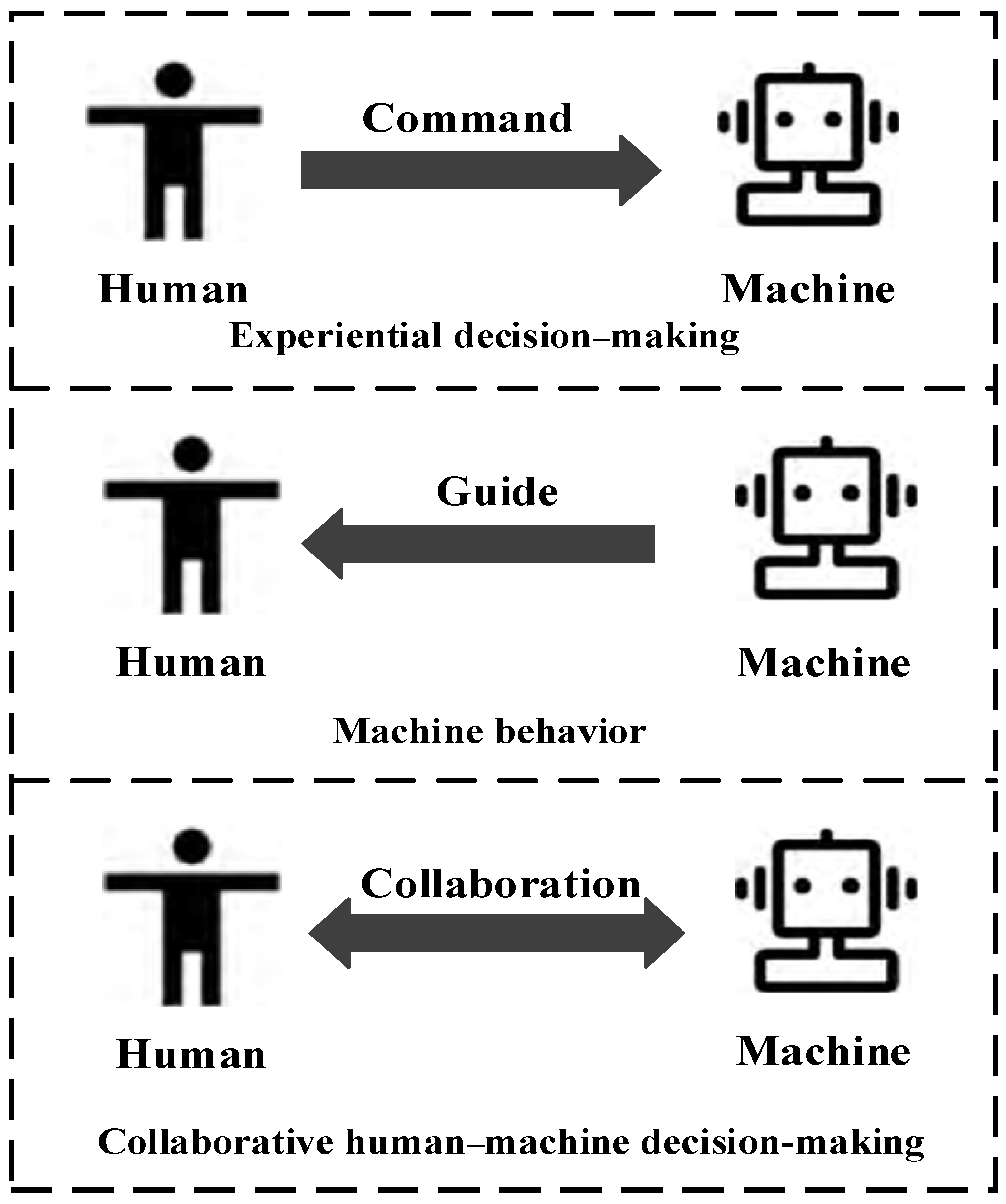

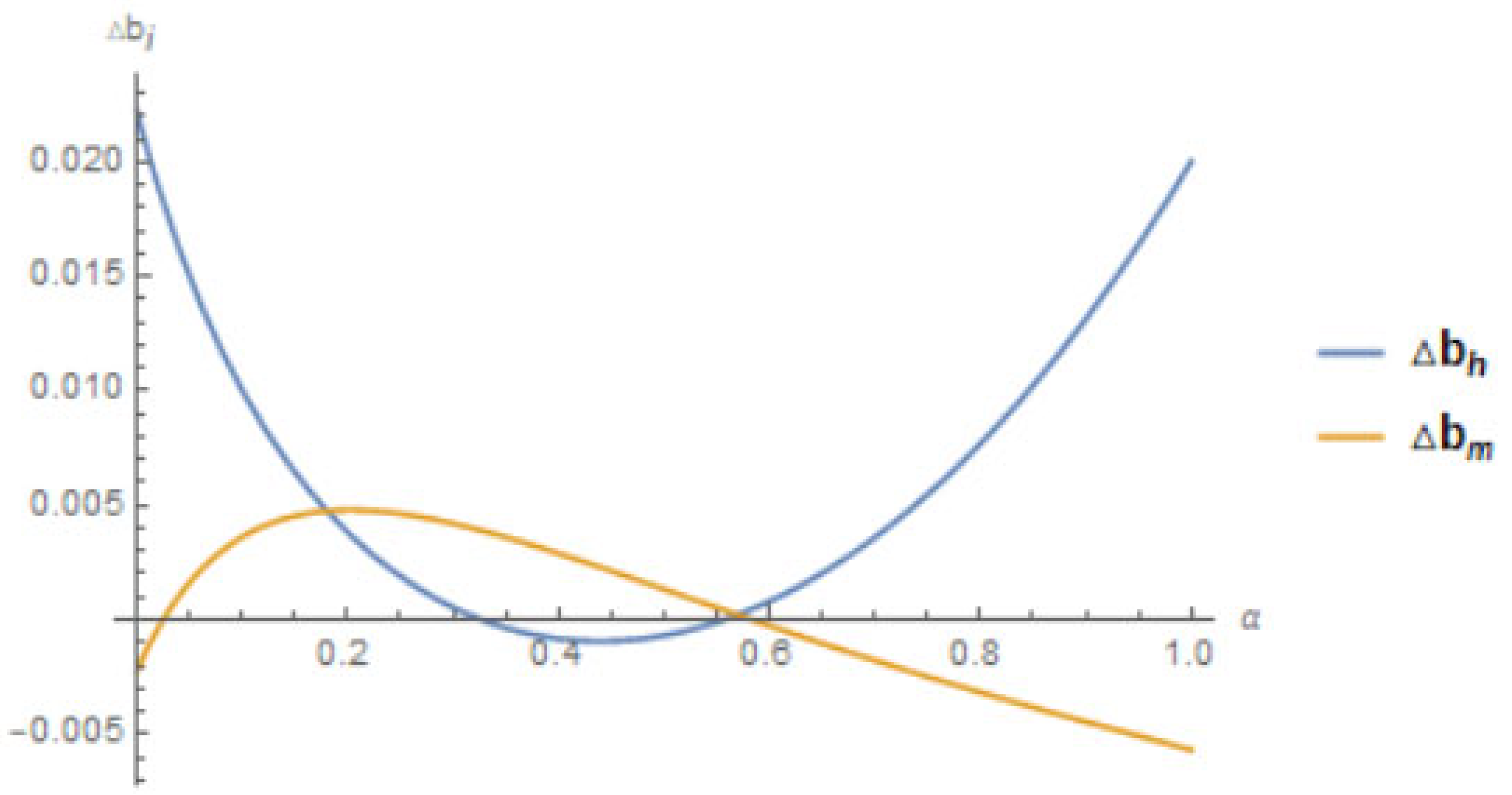

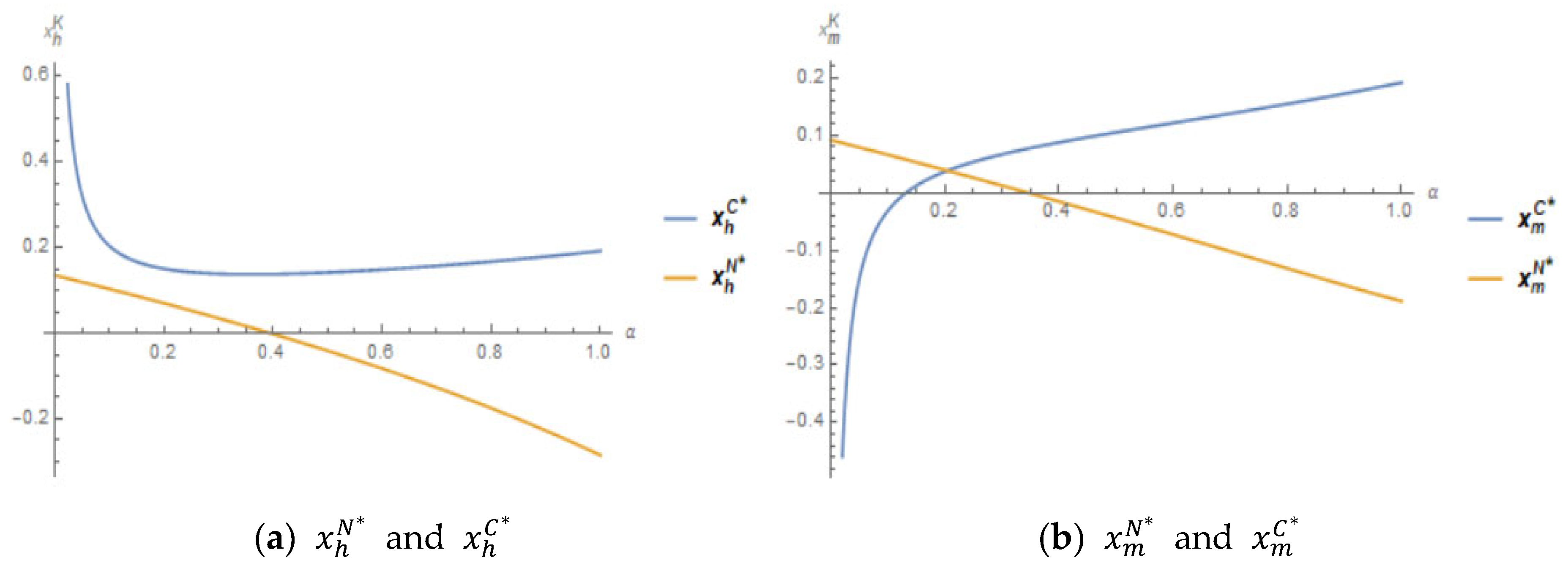
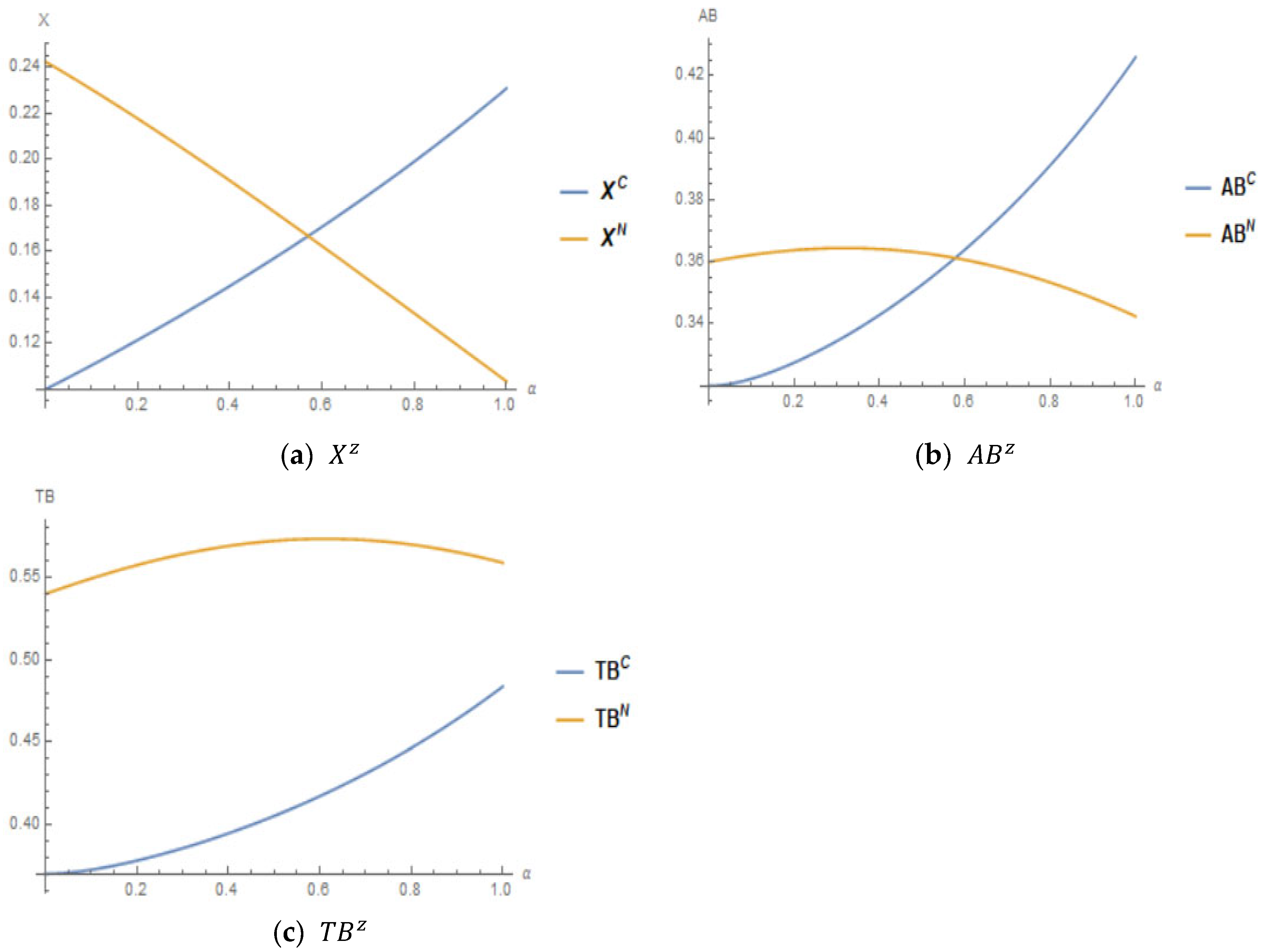

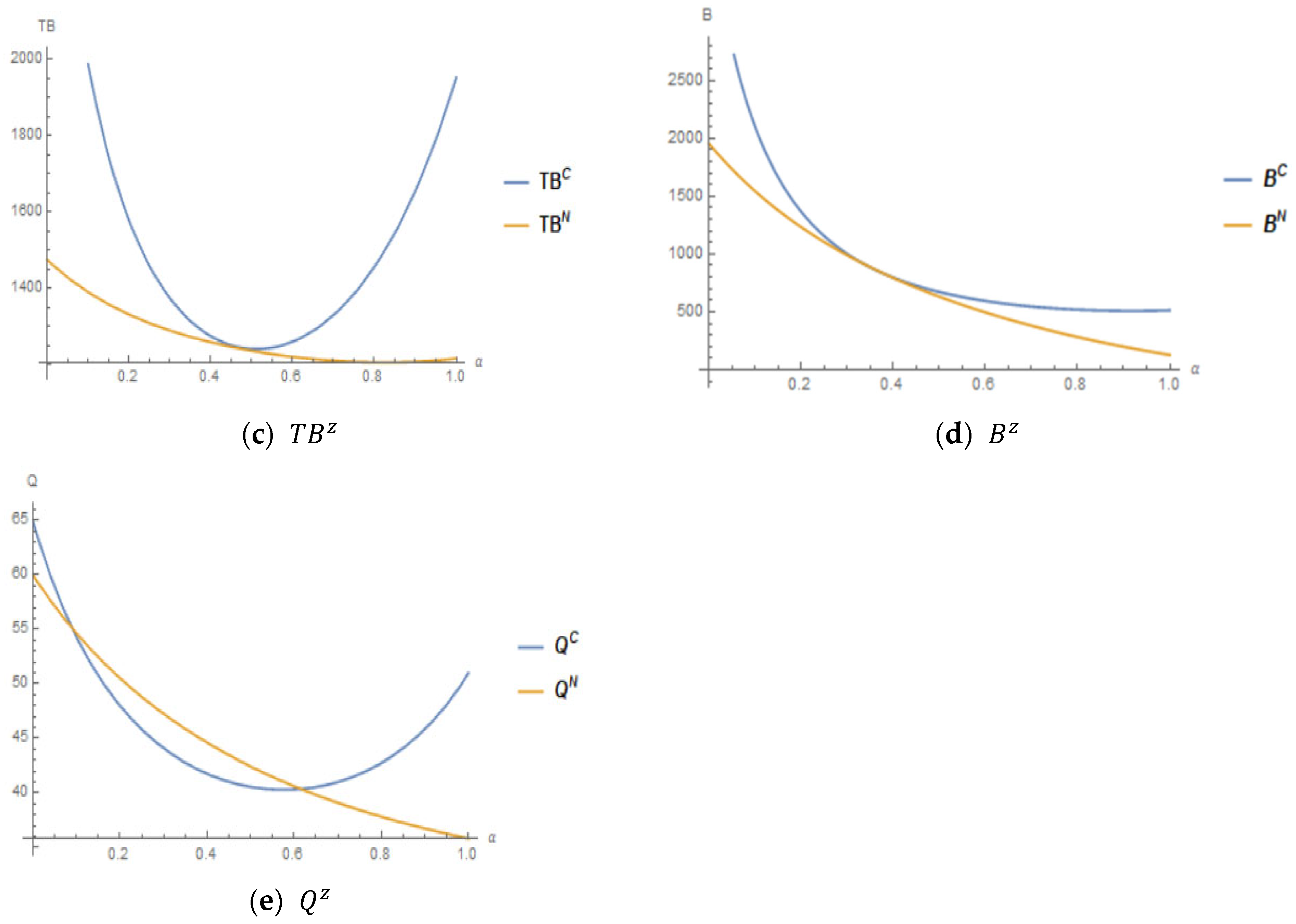
| Equilibrium | |
|---|---|
| S&T input | |
| Decision-making quantities | |
| Benefits | |
| The additional benefit | |
| Total Benefits |
Disclaimer/Publisher’s Note: The statements, opinions and data contained in all publications are solely those of the individual author(s) and contributor(s) and not of MDPI and/or the editor(s). MDPI and/or the editor(s) disclaim responsibility for any injury to people or property resulting from any ideas, methods, instructions or products referred to in the content. |
© 2025 by the authors. Licensee MDPI, Basel, Switzerland. This article is an open access article distributed under the terms and conditions of the Creative Commons Attribution (CC BY) license (https://creativecommons.org/licenses/by/4.0/).
Share and Cite
Shan, S.; Zhang, Y.; Hao, J.; Zhang, F.; Han, G. Sequential Game Model for Urban Emergency Human–Machine Collaborative Decision-Making. Appl. Sci. 2025, 15, 10083. https://doi.org/10.3390/app151810083
Shan S, Zhang Y, Hao J, Zhang F, Han G. Sequential Game Model for Urban Emergency Human–Machine Collaborative Decision-Making. Applied Sciences. 2025; 15(18):10083. https://doi.org/10.3390/app151810083
Chicago/Turabian StyleShan, Shaonan, Yunsen Zhang, Jinjin Hao, Fang Zhang, and Guoqiang Han. 2025. "Sequential Game Model for Urban Emergency Human–Machine Collaborative Decision-Making" Applied Sciences 15, no. 18: 10083. https://doi.org/10.3390/app151810083
APA StyleShan, S., Zhang, Y., Hao, J., Zhang, F., & Han, G. (2025). Sequential Game Model for Urban Emergency Human–Machine Collaborative Decision-Making. Applied Sciences, 15(18), 10083. https://doi.org/10.3390/app151810083







